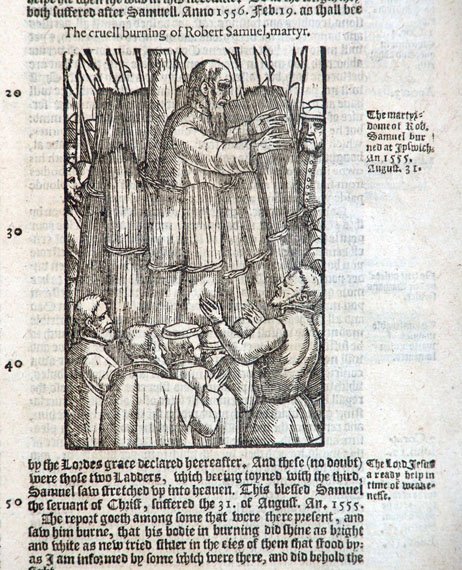Case Thinking
How does one move methodically from part to whole, from the particular to the general, when the part bears the burden of representing the whole? An individual case can exemplify a general rule or provide an exception to it; similar cases might be connected together through analogy in order to generalize from them. Attending as it does to circumstance and situation, case thinking (in any disciplinary field) is based in a radical particularity that can seem antithetical to method itself. In this context, textual strategies for dealing with the particular become unusually important for the constitution of method.
John Foxe's vast ecclesiastical history (Item 1) catalogues case after case of individuals martyred for the Protestant faith. Repetition is of the essence, since it is through repetition that martyrdom, as a form of subjection, could come to constitute national history. Although the individual case must have priority in the kind of story Foxe wants to tell, not least because of how Foxe means to affect the reader, it is also true that the logic of accumulation and repetition rendered the distinctions among cases secondary. The individual case is a form and formula; it is for this reason that the same illustration can usefully function in the book on pages 1528, 1547 and 1833 to represent three separate martyrs. The efficient use of this woodcut speaks to the fact that illustrations in early modern books did not have only a representational function, but could work simply to organize textual material on the page and to offer a symbolic or indexical cue to a topic. In the case of Foxe, that symbolic function encodes the constitutive tension for the book between historical case and historical method.
English lawyers thought about their practice in terms of particular legal cases, going to them both to learn the skills of pleading that were required in the courtroom and, increasingly, to extract from them the principles of the unwritten law. Edmund Plowden's collected reports of individual law cases (Item 2) was the first to print only cases in which general legal principles had been explicitly stated and could be abstracted as such (and so written into commonplace books like the one shown in the Commonplace Thinking section). As such, Plowden provided an important model for reporting the legal case in terms of generalizable law, a textual development that allowed precedent (or "case thinking" in the modern sense) to emerge as the dominant structure of English legal thought. Legal abridgements like Ashe's condensed version of Plowden (Item 3) helped lawyers avoid in another way the difficulties of sifting through innumerable particulars in their practical and case-by-case pursuit of method. Notice, too, how early readers of both Ashe and Plowden have left marginalia, the traces of their part in completing the book by synthesizing and generalizing from its particulars. The blank space of the margin is here critical matter for methodical work.



